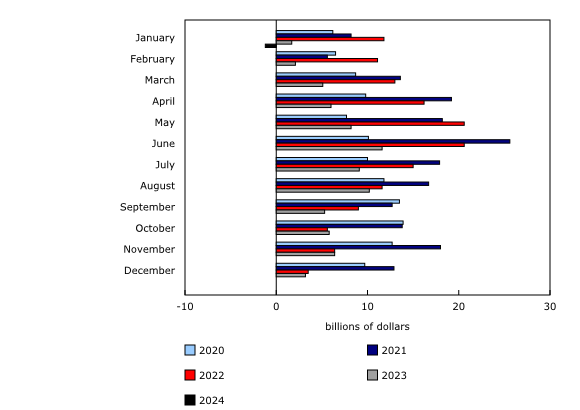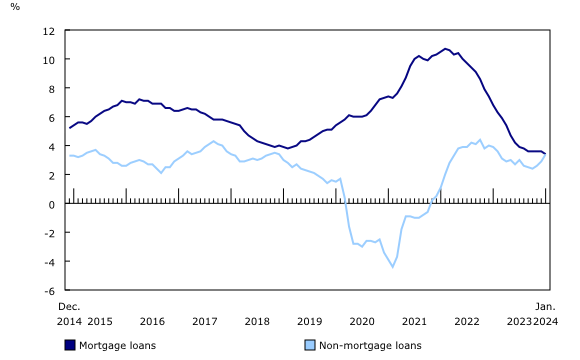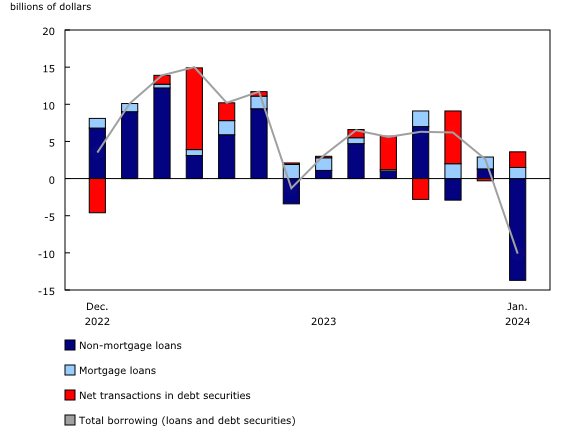Monthly credit aggregates, January 2024
Released: 2024-03-21
Household borrowing
In January, the total credit liabilities of households grew by $8.8 billion (+0.3%) to reach $2,928.6 billion. Real estate secured debt, composed of both mortgage debt and home equity lines of credit, increased $6.2 billion (+0.3%). Household mortgage debt rose $5.4 billion (+0.2%), a deceleration in growth compared with December (+0.3%). Compared with January 2023, household mortgage debt increased 3.4% in January 2024, marking the slowest year-over-year increase since April 2001.
Non-mortgage loan debt rose $3.5 billion (+0.5% monthly growth; +5.7% annualized growth) in January 2024, a slightly faster growth than that recorded in December (+5.6% annualized growth). On a monthly basis, outstanding balances on home equity lines of credit increased $0.9 billion (+0.5%) in January, and credit card debt with chartered banks rose $1.1 billion (+1.1%). The remaining non-mortgage debt categories grew by $1.5 billion (+0.3%).
Private non-financial corporation borrowing
Total credit liabilities of private non-financial corporations declined $3.0 billion (-0.1%) to reach $2,070.8 billion in January. Non-mortgage loans with chartered banks decreased $1.1 billion (-0.2%). Non-mortgage loans from government lenders dropped $11.8 billion (-21.9%), a more prominent decline compared with December (-5.9%), as businesses accelerated their Canada Emergency Business Account loan repayments given the program's January deadline. The value of debt security liabilities rose $7.0 billion in January, mainly as a result of exchange rate fluctuations.
Overall borrowing by private non-financial corporations, composed of the change in the level of seasonally unadjusted outstanding loans and the net transactions in debt securities, was -$10.1 billion in January.
Did you know we have a mobile app?
Get timely access to data right at your fingertips by downloading the StatsCAN app, available for free on the App Store and on Google Play.
Note to readers
Unless otherwise stated, this release presents data adjusted for seasonality.
Annualized percentage changes shown in this release are calculated by taking the seasonally adjusted value for a given debt item and applying the following formula: (((debtm/debtm-1)12-1)*100), where "m" is the reference month.
Revisions
This release of the monthly credit aggregates for the month of January 2024 includes revised estimates from January to December 2023. These data incorporate new and revised data, as well as updated data on seasonal trends.
Overview of the monthly credit aggregates
The monthly credit aggregates break down a portion of the quarterly National Balance Sheet Accounts (NBSA) by month. They provide details on lending to households and non-financial corporations—in other words, the stock of these sectors' outstanding liabilities from the debtor perspective—across a range of credit instruments, including mortgage loans, non-mortgage loans, and debt and equity securities. The aggregates cover all lending sectors, including chartered banks, non-bank deposit-taking institutions, other financial corporations, governments and other lenders. The estimates are presented as booked-in-Canada to capture activity within Canada, with either domestic or non-resident lenders. In addition, amounts are reported on an end-of-period basis (i.e., the value of the stock of an asset on the final day of the month). The third month of each quarter is benchmarked to the corresponding quarterly release of the NBSA.
Household sector borrowing is divided into financing in the form of non-mortgage loans (i.e., funds principally for consumption) and mortgage loans (i.e., debt acquired to finance the purchase of a property, whether residential or non-residential in nature). Household borrowing in the form of mortgage debt and home equity lines of credit is referred to as real estate secured debt and presents a further delineation of household liabilities associated with residential and non-residential properties.
As with the household sector, non-financial corporation borrowing is divided into non-mortgage and mortgage loans. However, overall credit liabilities of non-financial corporations also include their borrowing in the form of debt securities, with terms to maturity that are both short and long term in duration.
The NBSA are composed of the balance sheets of all sectors and subsectors of the economy. The main sectors are households, non-profit institutions serving households, financial corporations, non-financial corporations, governments and non-residents. The NBSA cover all national non-financial assets and all financial asset-liability claims outstanding in all sectors and, similarly, present stocks at the end of each quarter.
Estimates are available on a seasonally adjusted basis to improve the interpretability of period-to-period changes in debt. For information on seasonal adjustment, see the article "Seasonally adjusted data – Frequently asked questions."
For more information on the concepts, methodologies and classifications used to compile these monthly estimates, see the document "Guide to the Monthly Credit Aggregates."
Next release
Data on the monthly credit aggregates for February will be released on April 18.
Products
As a complement to this release, the documents "Guide to the Monthly Credit Aggregates" and "An overview of revisions to the Financial and Wealth Accounts, 1990 to 2023," which are part of Latest Developments in the Canadian Economic Accounts (13-605-X), are available.
As a complement to this release, the data visualization products "Financial accounts on a from-whom-to-whom basis, selected financial instruments," "Distributions of Household Economic Accounts, Wealth: Interactive tool" and "Securities statistics," which are part of Statistics Canada – Data Visualization Products (71-607-X), are also available.
The Economic accounts statistics portal, accessible from the Subjects module of the Statistics Canada website, provides an up-to-date portrait of national and provincial economies and their structure.
The User Guide: Canadian System of Macroeconomic Accounts (13-606-G) is available.
The Methodological Guide: Canadian System of Macroeconomic Accounts (13-607-X) is available.
Contact information
For more information, or to enquire about the concepts, methods or data quality of this release, contact us (toll-free 1-800-263-1136; 514-283-8300; infostats@statcan.gc.ca) or Media Relations (statcan.mediahotline-ligneinfomedias.statcan@statcan.gc.ca).
- Date modified:



